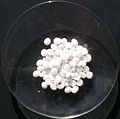Potassium hydroxide
| Potassium hydroxide | |
|---|---|
 | |
| General | |
| Systematic name | Sodium hydroxide |
| Other names | Potash lye |
| Molecular formula | KOH |
| Molar mass | Molar mass::56.10564 g/mol |
| Appearance | White solid, deliquescent |
| CAS number | CAS number::1310-58-3 |
| Properties | |
| Density and phase | [[Density::2.044 g/cm3]], solid |
| Solubility in water | 1100 g/L (25 °C) |
| Melting point | Melting point:: 360 °C |
| Boiling point | Boiling point:: 1320 °C |
| Structure | |
| Crystal structure | monoclinic |
| Hazards | |
| MSDS | External MSDS |
| Main hazards | highly corrosive |
| NFPA 704 | |
| Flash point | non flammable |
| R/S statement | R: R22, R35 S: (S1/2), S26, S36/37/39, S45 |
| RTECS number | TT2100000 |
| Related compounds | |
| Other anions |
Potassium oxide |
| Other cations |
Lithium hydroxide |
| Except where noted otherwise, data are given for materials in their standard state (at 25 °C, 100 kPa) Disclaimer and references | |
Potassium hydroxide (KOH) is an incredibly strong metallic base. It is very alkaline, and it has many uses in making industrial and commercial goods that are highly used today, such as in many agricultural and medical needs. It is also used in food preparation and has many chemical uses.
Properties
Potassium hydroxide is a very strong base, and it is highly corrosive. It could do much damage if not handled carefully. It corrupts organic materials, as well as inorganic materials, and though it is very dangerous, it is used in many cleaning agents and disinfectants for resistant surfaces and materials.
Potassium hydroxide is such a strong base that it is used to deprotonate many acids, which means to remove protons from it. It is even used to deprotonate the weak ones, which is tough for many bases to do because the proton is not very acidic,(making the molecule not give up its proton very easily). That's where potassium hydroxide comes in to do the job.[1]
Pure potassium hydroxide is a colorless, crystalline compound, which is solid, and is highly hygroscopic (meaning:the ability of a substance to attract water molecules from the surrounding environment through absorption.) It has a density of around 2.04 g/cm3. It has a high solubility, and it is readily soluble in water, lower alcohols, and other polar solvents. When being dissolved in water it produces a lot of heat. The temperature rises in the water, and can cause it to get to the point of boiling.[2]
Occurrences
Potassium hydroxide is not found abundantly in nature, but it does exist. The common name is potash lye. Many people thought of potassium carbonate with the name: potash, but now it can be referred to potassium sulfate, potassium chloride, potassium oxide, and potassium hydroxide.
"Potash" is still a widely used word referred to potassium compounds taken from the earth. People prefer to call of potassium compounds "potash" because they are used in manufacturing fertilizers. That is by far its greatest use.
In Colonial America, potash was one of the most widely used products. It was considered a necessity for the people living where the compound just so happened to be abundantly found in trees. In Colonial days, potash was easy to obtain from the ashes of burnt down trees.
Uses
There are so many applications for potassium hydroxide. Potassium hydroxide is a very important industrial chemical. It is used to manufacture many industrial goods and commercial goods and products like potassium salts, alkaline batteries, carpet cleaner degreasers, pipe cleaners, washing powders, certain kinds of soap, bleaching agents, and many others.
It is used in laboratories by helping scientists working in microscopy of herbarium, and it neutralizes acids with its deprotonization. It can be used to produce heat, and it is also highly used to corrupt and decompose materials.
It can be used as a fungicide to kill fungi, or a pesticide to kill harmful insects. It can neutralize soils with too much acid in it to be used for growing plants, making it very handy for farmers.[3]
History
In 1807, Sir Humphry Davy discovered that he could derive potassium from potassium hydroxide. It was a brilliant discovery of the time. He believed that he could isolate elements in compounds with a strong enough electric current to break up the bonds of the compound. His hypothesis was correct with potassium hydroxide, as well as sodium hydroxide. He chose those compounds because he believed that they could contain, if broken up, completely new elements. He used a method called electrolysis.[4]
 Browse |
References
- Safety tips for Potassium Hydroxide unknown author..
- Deprotonation encyclopedia
- Potassium Hydroxide Chemical Land
- Products containing potassium hydroxide unknown author..
- History of Potassium Hydroxide unknown author..
See Also
| ||||||||||||||


